Hall 1. «On the eve»
Before the beginning of the Great Patriotic War, the military units and subdivisions of the 4th army of the special West military district were located in the Brest region. They lined along the country border, near the outpost of the Belarusian border district and in the Brest-Lithuanian fortified district. The units of the 6th and 42nd rifle divisions, 33rd detached engineer regiment, military hospitals, and the subdivisions of the 132nd detached battalion of the NKVD escort troops were deployed in the fortress itself. The people living in Brest and other Belarusian regions were summoned to form an additional military force. The military units and compounds were located close to the country border, but considerably far from the frontiers that have been designed for defense purposes in case of war.
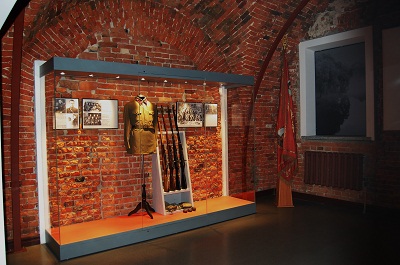
On the 22nd of June 1941, the fortress’ garrison consisted of about 9 thousand people total, which also included around 300 families of the commanding officers. The life was going according to the military laws: combat and political training, marches, exercises, recreation time. On the pictures in the glass case on the left, you can see commanders and regular soldiers from different military units and subdivisions. Here you can see the prewar uniform – the tunic of the USSR Red Army infantry sergeant from 1935 (the city of Vitebsk, 1941). In the pyramid you can see Mosin rifles from 1891/1930 years (1893, 1941, 1942 and 1943 years of production) and training grenades F-1, found in the South-East part of the defense casern after the war. Next to the training grenades lies the haversack of A. Radchenko, the military paramedic and the participant of the battles in Brest region. The prewar banner from one of the Belarusian border district outposts, standing next to the wall right from the glass case, will tell a story about the warriors that have been protecting the state borders.
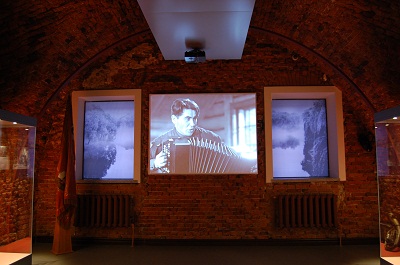
The projection screen, between the windows with the sights pictures, showcases the episodes from prewar feature films and documentaries. These films were watched by the fortress garrison warriors on the eve of the war:
“Djulbars” (1935)
“Circus” (1936)
“Seven brave men” (1936)
“Ruslan and Ludmila” (1938)
“On the border” (1938)
“The fourth periscope” (1939)
“Mannerheim line” (1940)
“Salavat Yulaev” (1940)
“The wind from the East” (1940)
“Valery Chkalov” (1941)
“Front-line friends” (1941)
Weekdays and holidays of the military service were also shared by the families of the Brest garrison commanding officers. Political lectures, motorcycle and shooting trainings, driving and horse riding became a regular thing for women. The work of amateur talent groups was finely coordinated, and various sport activities were very popular. Women’s councils contributed to the improvement of soldiers’ daily lives and also helped with the apartments distribution.
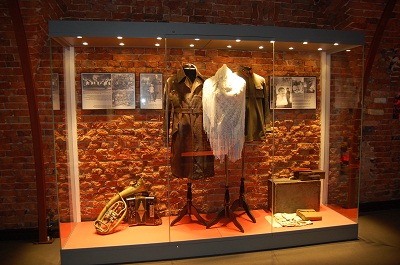
In the second glass case of the left half of the hall you can see different prewar pictures and objects, telling the stories about the peaceful life: the leather coat of the captain A. Korobko; the prewar shawl of the Brest resident P. Nagaeva; the tunic of the 2nd rank military doctor S. Babkin; the alt trumpet (requisite) of Sasha Akimov, the musical troop pupil from the patriotic drama film “The Brest Fortress”, who was played by A. Kapashov; the prewar accordion of F. Ryabov, the private soldier from the 132nd detached battalion of the escort NKVD troops.
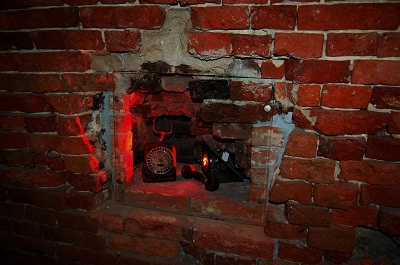
The walls of the casemates are used as showcases, where you can find different objects, found in the fortress after the war.
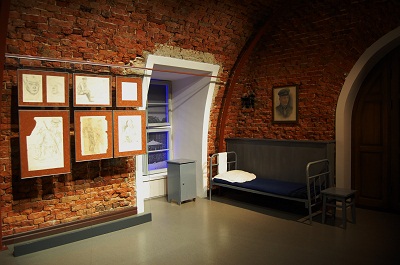
The daily life of the soldiers are portrayed with the casern reconstruction, prewar pictures, prewar drawings, made by the junior leutenant of the 84th rifle regiment V. Faddeev, who was doing his military service in the fortress before the war. Around 300 of his works are being stored in the foundation of the memorial.
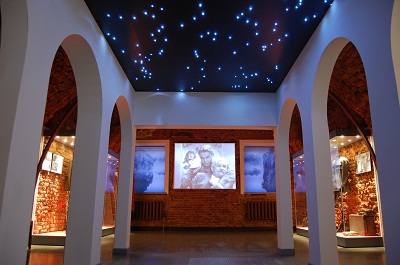
The sounds of the last peaceful night can be heard within the reconstruction of the three-arch gates. The fortress garrison was sleeping peacefully, while on the other side of the Western Bug river the Wehrmacht soldiers were finalizing the last preparations before attacking the Soviet Union.
